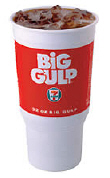7-Eleven's precious shelf space


We're able to track actual behavior by having technology facilitate a trial-and-error process of market research. For example, when we're going to introduce a new bottled water, we can have two options. The traditional way would be to do some market research on what customers like in terms of enhancements—flavorings, vitamins added, etc.
What we do instead is try three or four [water products] with different flavorings, with different nutritional enhancements, and we can within a very brief period of time determine how the customer behaved by the actual velocity of the items in different stores. By measuring our sales velocity in different stores with different demographic presence, we can get a read on actual behavior rather than predictive behavior.
Keyes said that his objective is to control his shelf space, increasing the sales per square foot. With 28,000 stores, each averaging between 2,400 and 3,000 square feet and carrying about 2,500 different items, that turns out to be a lot of number crunching.